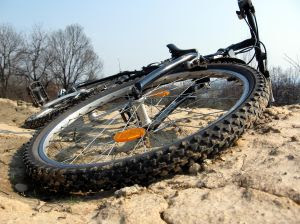
Forget those expensive titanium bolts or that carbon fiber head stem; if you want to dramatically increase your bike's speed there is a much cheaper and more beneficial way. Having a wiser tyre choice is guaranteed to increase both your rolling speed and handling when matched to the right terrain.
The rotating mass on your rims make the biggest difference when it comes to shedding your bike's weight. This matched with a cunning tread pattern and fast rubber compound poses a great increase in speed and efficiency.
Weight
As we've established, weight off your rims makes a great difference in speed. Heavier XC tyres weigh in at more that 700g (1.4kg a pair!) while lighter models can be as slim as 310g (620g a pair). That's a pretty massive saving on rotational weight. If you can find another way to save 780g at a cost of (give or take) $120 than I'd love to hear it!
Compounds/construction
Rubber tyre compounds vary from hard to soft. Harder compounds are more likely to reduce the rate of wear while softer compounds are usually offer more grip. XC tyres are commonly seen with a softer compound so traction isn't so reliant on the knobs.
Threads per inch (TPI) refers to the tyres casing construction. Higher Quality tyres have a higher count of TPI. The more threads per inch, the lighter the fabric and the more flexible (less rolling resistance) it is.
Sidewalls
The sidewall of the tyre has the greatest influence on rolling resistance. When looking at tyres, inspect the sidewalls by folding/rolling them through your fingers. Tyres with more flexible sidewalls generally have less rolling resistance. A good test for comparing rolling resistance is to inflate a tyre on a rim and bounce it, tyres that bounce higher will have less rolling resistance.
Tread Patterns
The tread pattern on your tyres greatly influences how your bike handles in different conditions. Generally a tread with wider spaced knobs offer better grip on things like wet roots/rocks or on sandy/muddy surfaces. These tyres may grip well but on smoother surfaces you may find that their rolling resistance is much higher compared to a tyre with a hardpack specific tread. You will often see that tyres designed for hardpack surfaces will have a tread pattern with a closer and lower profile; they may even have a centre rolling ridge (e.g. Maxxis Crossmark) to reduce rolling resistance further. However, the problem with a centre rolling ridge (or hardpack tread pattern) is that they're generally not very responsive under breaking when riding on looser surfaces. The key to choosing the right tread pattern is to assess the terrain you mostly ride and how fast or grippy you'd like it to be.
Carcass shape (profile)
The carcass shape of your tire is pretty much down to personal preference. The shapes vary between tyre models from fairly square with an edge to more rounded profiles. In my experience, tyres with and edge-like profile offer a responsive bight into corners while rounded profiles tend to roll around the corners. Rounded tyres will slide/drift quite predictably whereas square profiles are more likely to give way under pressure.
Tyre Dimensions
There is no evidence to suggest that a bigger (e.g. 26x2.9 VS 26x2.1) tyre will have less rolling resistance but keep in mind that a bigger tyre may be heavier than a skinnier one. Bigger tyres have more contact area with the ground and can offer more grip than a skinnier model.
Tyre Pressure
It has been confirmed that at below 30psi the rolling resistance is rapidly increased while above 35psi the resistance rate drops off. It is,however important to set your tyre pressure according to your weight and the riding terrain. Lighter people can get away with lower pressures while heavier or faster people need higher pressures to prevent pinch-flats.
Tyres can be the cheapest performance boost or the slowest dead weights you can hook up on your rims so choose wisely!
Related articles
Image by Paweł Zawistowski
